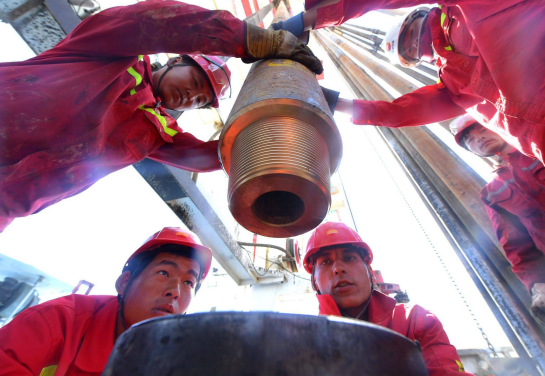Oil drill pipe is a critical component in drilling operations (such as oil exploration and production, well workovers, and geothermal development). Its handling precautions directly impact drilling efficiency, safety, and equipment life. The following are key precautions to pay attention to when using oil drill pipe, covering operating procedures, maintenance, and safety risk prevention:
Operating Specifications and Usage Requirements for Drill Pipe:
1. Drill Pipe Connection and Disassembly
Thread Cleaning and Lubrication:
Before make-up, thoroughly clean the threads to remove impurities such as mud and rust to prevent thread damage.
Use a special thread compound (such as an API-certified product) to evenly coat the threads to reduce friction and prevent galling.

Torque Control:
Use a torque wrench or hydraulic make-up machine to make-up according to API standards or manufacturer recommendations (for example, the torque value for
S135 steel grade drill pipe is typically 25,000-30,000 ft·lbs).
Avoid excessive torque, which may cause thread deformation, or insufficient torque, which may cause leaks.
Alignment and Alignment:
When making up, ensure that the axes of the male and female connectors are aligned to avoid damaging the threads due to skewed threading. During deep well operations, a centralizer can be used to assist with alignment.
2. Drilling Parameter Control
Weight on Bit and Speed:
Adjust the weight on bit according to the formation hardness and drill pipe steel grade (reducing the weight on bit in hard formations) to avoid overloading the drill pipe.
The speed must be matched to the fatigue life of the drill pipe to prevent fatigue fracture caused by high-frequency vibration.
Drilling Fluid Management:
Control the density and flow rate of the drilling fluid to prevent erosion of the drill pipe inner wall (for example, high-flow rates of sand-laden drilling fluid will accelerate wear).
Regularly test the pH value of the drilling fluid to prevent acidic media from corroding the drill pipe.
3. Downhole Condition Monitoring
Torque and Drag Monitoring:
Monitor the torque and drag of the drill string in real time. Stop drilling and inspect any abnormal increases (such as sticking or bent drill pipe).
Vibration and Shock Detection:
Use vibration sensors to monitor the lateral and longitudinal vibration of the drill pipe to prevent resonance-induced fatigue failure.
Drill Pipe Maintenance and Care Requirements:
1. Daily Inspection
Visual Inspection:
After each trip, inspect the drill pipe surface for cracks, wear, or corrosion (focus on the
drill pipe tool joints, upset sections, and pipe body).
Use an ultrasonic flaw detector to check wall thickness. Any reduction in wall thickness exceeding 12.5% (API standard) requires scrapping.
Thread Inspection:
The thread profile is intact. Any wear on the thread crest exceeding 0.03 inches (0.76 mm) requires repair or replacement.
Check the thread root for cracks or deformation.
2. Storage and Transportation
Storage Conditions:
Drill pipe should be stored horizontally in a dry, ventilated warehouse to avoid corrosion caused by humidity.
Use dedicated supports to prevent bending or deformation.
Transportation Requirements:
Drill pipe must be secured during transportation to avoid collision damage.
Do not stack heavy objects on top of drill pipe.
3. Repair and Scrap
Thread Repair:
Minor thread wear can be repaired by turning or overlay welding, but the pipe must be re-machined to standard dimensions. Repaired threads must pass magnetic particle or penetrant testing.
Scrap criteria:
Drill pipe with wall thickness reduction exceeding the specified value, crack depth exceeding 10% of the wall thickness, or severe thread damage must be scrapped immediately.
Safety Risk Prevention:
1. Fatigue fracture prevention
Avoid alternating loads:
Reducing frequent tripping and drilling operations reduces the risk of fatigue damage to drill pipe.
In deep well operations, use
heavy-weight drill pipe (HWDP) or high-strength steel grades (such as S135) to improve fatigue resistance.
Regular replacement:
Develop a replacement schedule based on drill pipe age and accumulated well depth (e.g., inspect drill pipe condition every 5,000 meters).
2. Corrosion protection
Material selection:
Use sulfur-resistant drill pipe (such as 13Cr steel) or coated drill pipe in formations containing hydrogen sulfide or carbon dioxide.
Environmental control:
Add corrosion inhibitors to the drilling fluid to reduce the corrosion rate.
Regularly inspect drill pipe surface corrosion and address it promptly.
3. Operational Safety
Personnel Training:
Operators must be familiar with drill pipe usage specifications and safe operating procedures.
Emergency Plan:
Develop emergency response plans for accidents such as drill pipe breakage and leakage to ensure rapid response.
Precautions for Special Working Conditions:
1. Deep and Ultra-Deep Wells
Use of Heavy-Weight Drill Pipe:
Insert heavy-weight drill pipe between the
drill collar and standard drill pipe to reduce drill string fatigue.
Optimize Drill Tool Assembly:
Use a tower-type drill tool assembly to reduce drill pipe bending stress.
2. Horizontal Wells and Extended Reach Wells
Torsion and Bending Resistance Design:
Use high-torque drill pipe and flexible joints to reduce friction between the drill pipe and the wellbore wall.
Drilling Fluid Lubrication:
Improve the lubricity of the drilling fluid to reduce torque and friction.
3. High-Temperature and High-Pressure Formations
Material Upgrade:
Use high-temperature-resistant
alloy steel drill pipe.
Enhanced Seals:
Use metal-to-metal sealing joints to prevent leakage under high temperature and high pressure.
Conclusion:
Drill pipe usage must strictly adhere to operating specifications, combined with regular maintenance and risk prevention measures, to ensure safe and efficient drilling operations. Key points include:
Thread cleaning and torque control: Avoid thread damage and leakage.
Drilling parameter optimization: Prevent drill pipe overload and fatigue fracture.
Regular inspection and scrapping: Promptly identify and address potential hazards.
Adaptation for special working conditions: Select appropriate drill pipe material and structure based on formation conditions.
Read more: Drill Pipe Price and Cost or API 5DP Drill Pipe Specification and Size


